
Zoom has recently become a well-known app in the technology industry. The app’s popularity has come due to the recent COVID-19 pandemic. Due to the limits put on physical contact, most businesses and individuals needed a solution that allowed them to collaborate and meet online. Zoom’s product was the perfect solution for their needs.
Zoom was founded in 2011. However, it wasn’t until late 2012 that the company launched its online app and platform. The company also went public in 2019, getting a valuation of $16 billion by the end of the first trading day. Zoom had many high-profile clients, such as the University of Stanford. However, it experienced a significant surge of new customers during the pandemic.
Zoom reported 200 million+ daily meeting participants recently compared to the 10 million in December 2019. Similarly, the app broke many records on various app stores for the most downloaded app. Due to the significant increase in the downloads and customer count, Zoom also generated significant revenues. Zoom’s business model was the centre of attention for many.
Zoom’s business model has allowed it to be a profitable business. However, most people wonder what Zoom’s business model is and how it makes money. Given below is a description of both of these.
What is Zoom’s Business Model?
Zoom’s business model is straightforward and something that has existed for a long time. Zoom uses a freemium business model. With this model, companies provide products and services for free. However, they put specific limits on their products, after which customers have to pay. The freemium business model is highly successful in the technology industry.
Zoom offers customers a free plan. Through this plan, customers can have unlimited one-to-one meetings. The limit on the app comes for group meetings, where it only allows 40 minutes of meetings with up to 100 participants. For most customers, the free plan may be enough to benefit from the app’s features.
However, most corporate and professional clients may use the paid features that increase the limits for usage. For example, schools, colleges, and universities using the app pay to use the professional features. Through this, Zoom makes a significant amount of money. In this aspect, Zoom uses a subscription-based model, where customers have to pay a monthly fee to use the app.
Zoom’s business model is highly dependent on its number of users. The more users that use the app, the more Zoom can make money. Due to the recent influx of users to the platform, Zoom’s profitability has increased significantly. Zoom made revenues of only $2.651 billion in 2021. However, the app significantly improved its revenues in 2022.
In 2022, Zoom generated revenues of $4.099 billion (As of 31 January 2022). It was a staggering increase of 55% over the revenues generated in 2021. It was before the pandemic, which shows the app was successful before the pandemic. However, it was also the same year as the company went public. So, some experts believe that it may have had an impact on the revenues.
Similarly, Zoom generated revenues of $2.651 billion in 2021. While it was a significant increase of 326% from 2020. Compared to 2018, the company increased its revenues by more than five times. The significant increase in profits was primarily due to the rise in the number of users.
Lastly, the company experienced almost double revenues in each quarter of 2020. Given below is a summary of Zoom’s quarterly revenues in the last two years.
| Description | 2019 (USD Millions) | 2020 (USD Millions) |
| Q1 | 60.07 | 121.99 |
| Q2 | 74.53 | 145.83 |
| Q3 | 90.12 | 166.59 |
| Q4 | 105.8 | 188.25 |
| Total | 330.52 | 622.66 |
How Does Zoom Make Money?
Zoom earns its revenues from several sources. It provides its customers with different plans and packages from which they can choose. Zoom does not make money from its free features. Unlike other apps that use the freemium model, Zoom does not display ads on its app. Therefore, it cannot generate any ad revenues. However, the free version of the app does a great job of showing its features and attracting new users.
Zoom makes money from its paid services. These include the following plans and packages.
Subscription Plans
Zoom has four different subscription plans through which it earns money. The company has its basic plan where it does not charge anything from its customers. As mentioned, it allowed unlimited 1-to-1 meetings, 40 minute limit on group meetings, up to 100 participants, and some other basic features.
Zoom Pro
The second plan is the pro plan. Zoom charges its customers $149.90/year/license from its customers. The pro plan includes up to 30 hours of group meetings, social media streaming, 1 GB cloud recording per license, and up to 1,000 participants with large meetings. It also includes better support compared to basic users.
Zoom Business
The next plan is for small and medium businesses. It can host up to 300 participants and increase the limit to 1,000 with a large meetings add-on. It includes other features such as recording transcripts, managed domains, company branding, single sign-on, and all pro-plan features. This plan costs $199.90/year/license.
Zoom United Business
The next plan is the Zoom United Business plan. This plan costs $350/year/license. Similarly, it includes all the features that come with other plans. On top of that, it includes Zoon United Pro phone features, unlimited calling within global select, optional add-ons. It also has meeting features such as host meetings of up to 300 participants and other features.
Zoom Enterprise
Zoom enterprise is Zoom’s largest plan for customers. IT costs $240/year/license. It includes all features available in the other plans. It also includes meetings that can host up to 500 participants, unlimited cloud storage, a dedicated customer success manager, and other custom features. It also includes executive business reviews and bundle discounts.
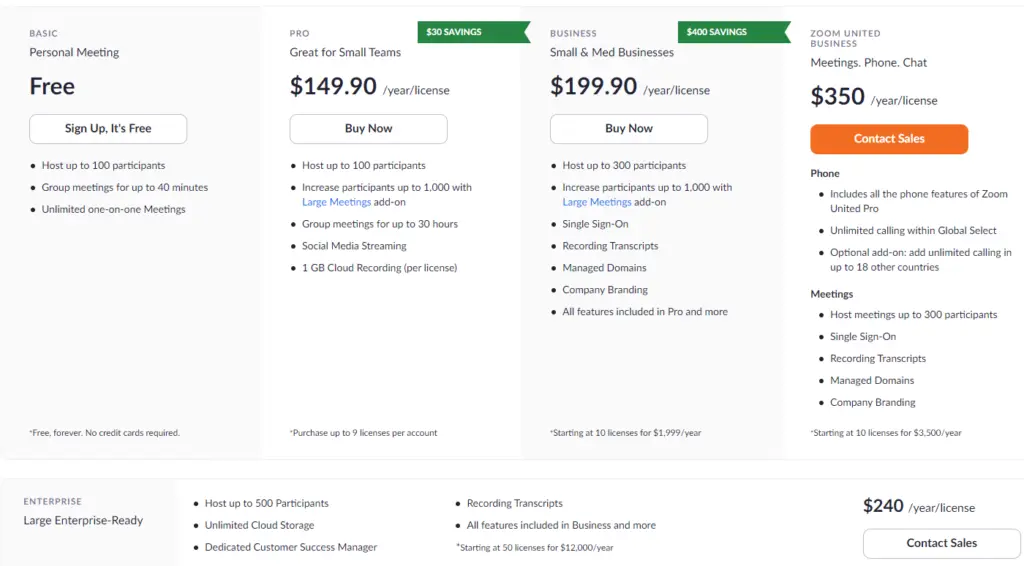
Zoom Meetings Add-Ons
Add-ons are features that are not a part of the Zoom subscription plans. These add-ons allow users to increase their limits or order other features without paying for higher plans. These include features such as video webinars or increasing group meeting participant limits. These add-ons are only available to pro and business plan users.
Free users can’t get these add-ons. Similarly, higher plans already have most features included and may not need to order them separately. Add-ons also come with a monthly subscription plan.
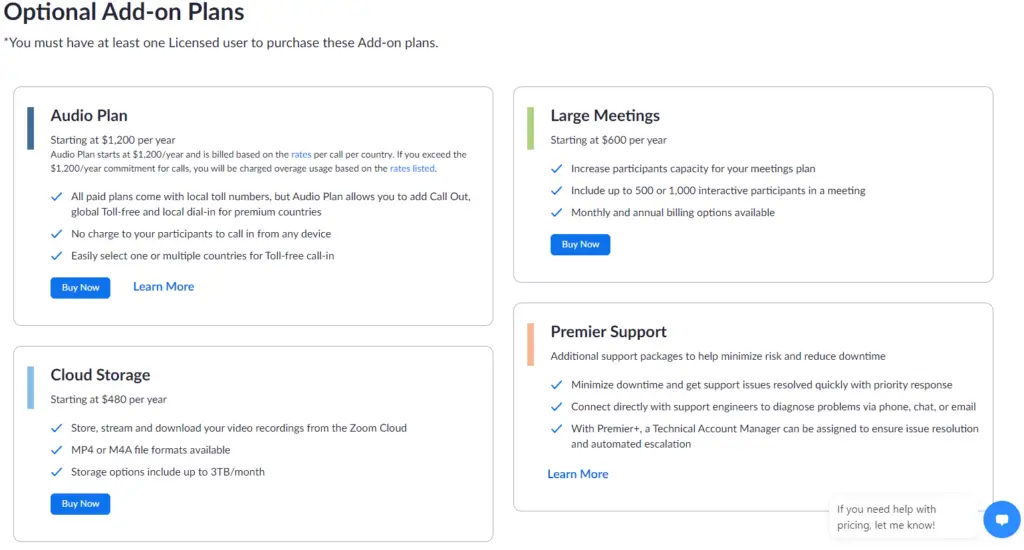
Zoom Phone
Zoom also provides phone plans to users. These include four tiers of paid plans. With the phone feature, customers can receive features, such as a US & Canada or a direct dial number. They can also call domestic or international numbers based on the plan they choose. Zoom Phone also comes with SMS and MMS features.
It also includes other features such as advanced phone features, making and receiving calls from multiple devices, unlimited calls and much more. Customers have to pay for this package in addition to the Zoom Meeting plan. Zoom phone plans include $120, $180, $240 and $350 plans per year per license. Given below is a summary of the plans.
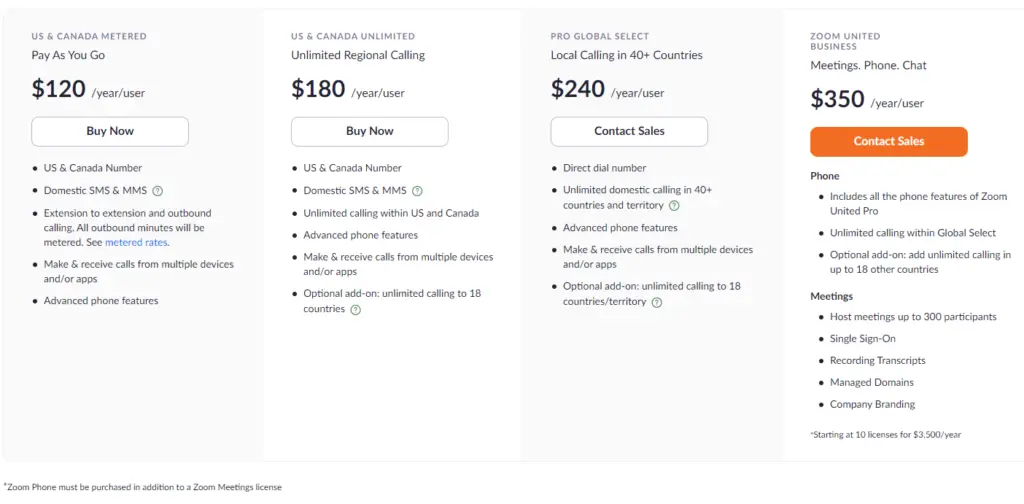
Zoom Phone Add-Ons
Zoom Phone also comes with add-ons. These include International Calling Add-On for $120 per year. Similarly, it allows additional phone numbers, which start at $60 per year. As with the meeting add-ons, customers have to be subscribed to a licensed plan to use these.

Zoom Video Webinar
Zoom also has a video webinar feature that lets hosts conduct online webinars. It allows various features such as interactive video panellists, Q&A feature, in-webinar text-chat, polling, muting options, performance reports, etc. It also has several other features that allow both the hosts and participant more flexibility in their options. Given below is a list of all the features for the Video Webinar feature.
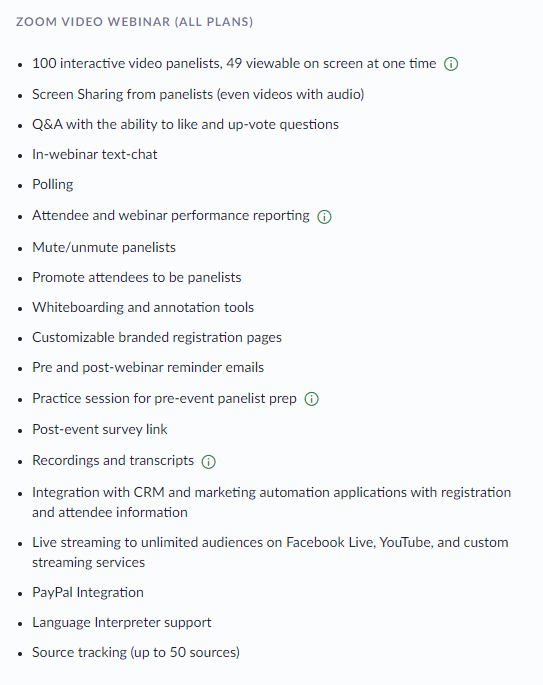
The Zoom Video Webinar features allow the app to earn more than any other plans or features. There are six different plans for users to choose from based on the number of attendees they expect. The plans start from $400/year/license for 100 attendees up to a whopping $64,900/year/license for 10,000 attendees. Zoom also offers bigger plans. However, customers have to get in contact with the team to get custom prices.
Given below is all the plans for the Zoom Video Webinar feature.
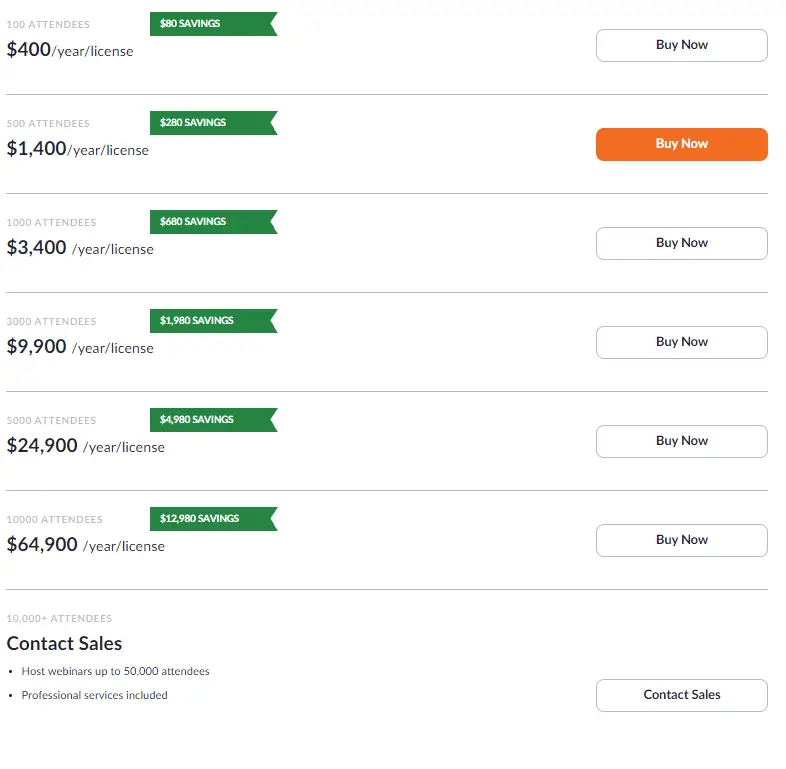
Zoom Video Webinar Add-Ons
Like other features, users can also choose from different add-ons for the video webinar plan. These include an Audio plan at $1200 per year and cloud storage at $480 per year. Here’s the summary.
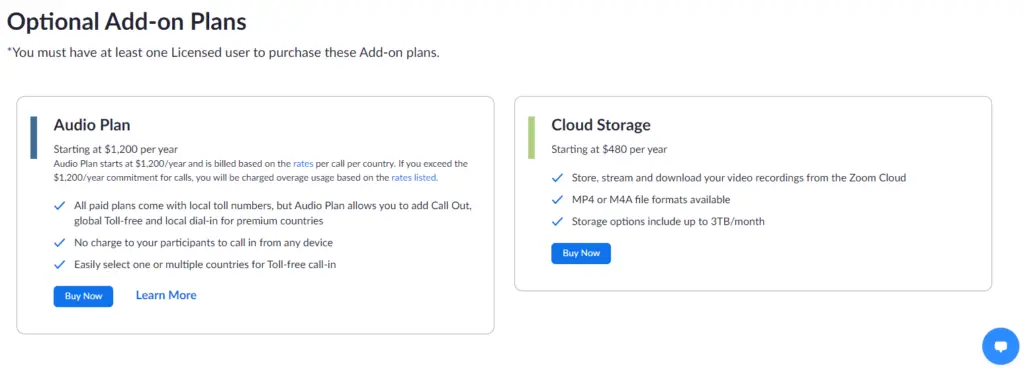
Zoom Rooms
Zoom also has rooms features, which allows easier meeting solutions. It has a 30-day trial plan that users can use for free. However, after that, users must pay $499/year/room and purchase up to 49 Zoom Rooms license. They can also get better enterprise solutions by contacting support. A list of all the features for Zoom Rooms is as below.
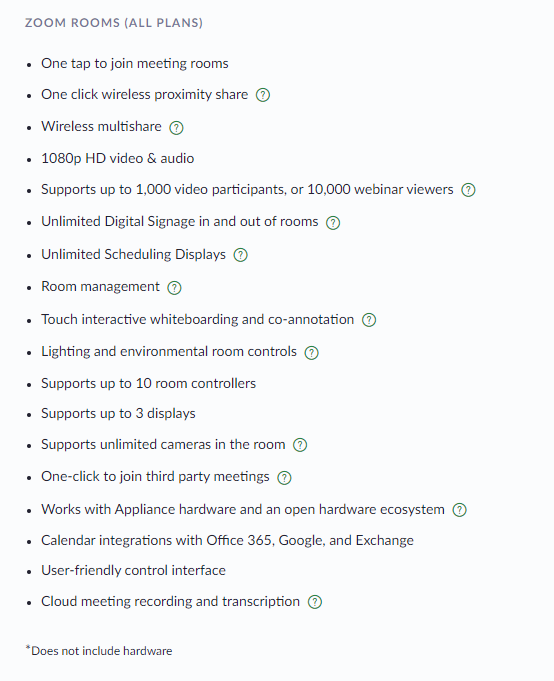
Zoom Room Add-Ons
Zoom Rooms has three add-ons. These include conference room connector, hardware as a service and professional services. Given below is a summary of these add-ons.
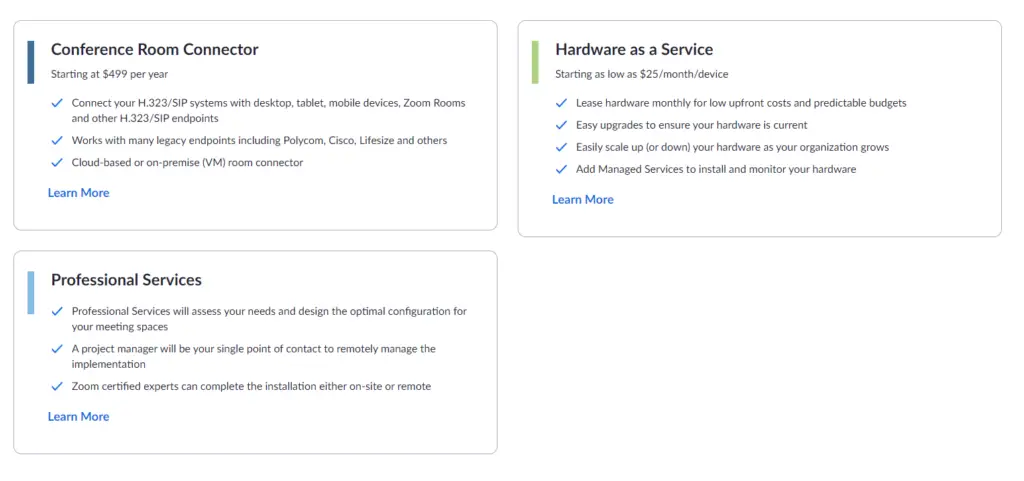
Zoom United
Zoom also bundles various packages into one through its Zoom United plan. The prices may be different from other packages. However, it allows customers to order several Zoom plans for lower prices. Here is a summary of the Zoom United plans that customers can get.
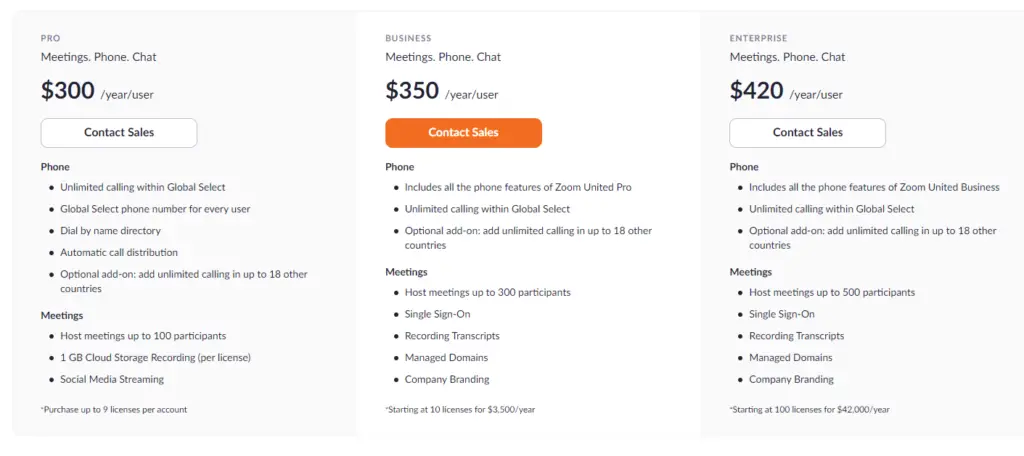
Zoom United Add-Ons
Zoom United also comes with add-ons. These include international calling and additional phone numbers, same as for Zoom Phone plans.

Conclusion
Zoon is an online video conference and collaboration tool. The app gained significant popularity during the pandemic. While Zoom uses a freemium business model, it still makes income. The primary source of income for the app is through its subscription plans. These include Zoom Meetings, Zoom Phone, Zoom Video Webinar, Zoom Rooms and Zoom United. Zoom also has several add-ons for each of these packages for which customers have to pay.

